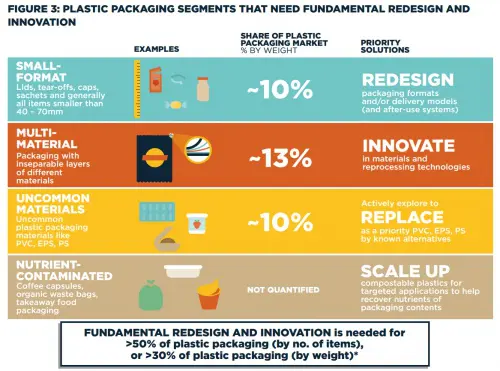Europe – ‘Concerted efforts’ to redesign packaging and waste management systems could render recycling economically attractive for 50% of plastic packaging, say the World Economic Forum and the Ellen MacArthur Foundation in a new study.
‘Without fundamental redesign and innovation, about 30% of plastic packaging will never be reused or recycled,’ the report says. This waste stream consists of four segments: small-format packaging; multi-material packaging; uncommon plastic packaging materials; and nutrient contaminated packaging.
‘For at least 20% of plastic packaging, reuse provides an economically attractive opportunity,’ it is added. For instance, personal and homecare bottles and shopping bags alone could generate about 6 million tonnes of material savings and an economic opportunity of US$ 9 billion.
It is pointed out that approximately 330 billion single-use shopping bags are produced every year – that is over 10 000 bags per second. The report stresses that multi-material packaging – which represents about 13% of the market, by weight – currently cannot be economically, and often not even technically, recycled.
Meanwhile, small-format plastic packaging represents 10% of the market, by weight, and up to 35%- 50% by number of items. This stream includes sachets, tear-offs, lids, straw packages, sweet wrappers and small pots, which tend to escape collection or sorting systems and ‘have no economic reuse or recycling pathway’.
Both the World Economic Forum and the Ellen MacArthur Foundation assert that the ‘global momentum for a plastics rethink is greater than ever’. They decided to focus the study on plastics packaging because it represents the biggest market share (26%) by total volume, and affects everyone on pretty much a daily basis.
Most plastic packaging is used only once and 95% of its value, estimated at US$ 80-120 billion annually, is lost to the economy after its initial use. ‘This new report shows that we are now firmly at the action stage,’ the project partners agree.
‘The initiative has solidified its five building blocks – dialogue, harmonisation, innovation, analysis and outreach – and each has catalytic actions planned for 2017.’
The entire report can be downloaded here for free.

Don't hesitate to contact us to share your input and ideas. Subscribe to the magazine or (free) newsletter.



